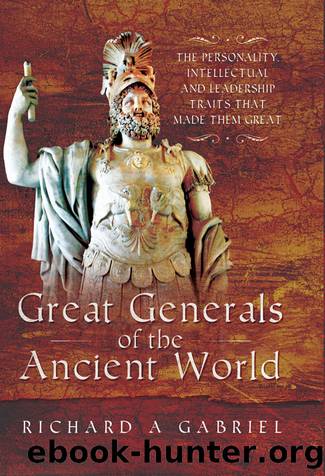Great Generals of the Ancient World by Unknown

Author:Unknown
Language: eng
Format: epub
Tags: BIOGRAPHY & AUTOBIOGRAPHY / Presidents & Heads of State
ISBN: 9781473859104
Publisher: Pen and Sword
Published: 2017-01-30T00:00:00+00:00
Now Hasdrubalâs cavalry arrived in the Roman rear to block their retreat, completing the double envelopment of the Roman infantry. Having assured himself that the allied cavalry was clear of the field, Hasdrubalâs cavalry âby charging the Roman legions on the rear, and harassing them by hurling squadron after squadron upon them at many points at once began massacring the Roman rear line.â40 With no ability to move forward or to the flanks, and with the rear cut off, the Roman army was slaughtered where it stood.
It was, however, no easy task. Hannibalâs men organized in units struck with one combat pulse after another, hour after hour, against the Roman mass, which put up stiff resistance for a long time before, eventually, all resistance collapsed and the survivors fled. Livy says that of the original force of 80,000 men, 45,000 infantry and 2,700 cavalry were killed.41 From other passages in Livy, it emerges that some 19,000 may have been taken prisoner, some of these having reached the Roman camp and surrendered later.42 The Carthaginians lost 5,700 men, including 4,000 Gauls fighting in the centre of the line. Another 1,500 Africans and Spanish infantry died, and about 200 cavalrymen. Hannibalâs casualty rate was by no means insignificant, however, amounting to 11.5 per cent of his force, or three times the average loss rate suffered by victorious armies in antiquity, a figure that testifies to the fierceness of the fighting even after the Romans were surrounded. The total butcherâs bill was 54,000 men heaped in an area roughly the size of New Yorkâs Central Park.
Hannibal had achieved his great victory over the Romans. In the three battles of Trebia, Trasimene and Cannae, the cost to Rome in military manpower had been horrendous. No fewer than 100,000 men, almost 20 per cent of the Roman population of military age, had been killed, captured or wounded.43 Hannibalâs army was intact and capable of further offensive action. Polybius says that while Hannibal and Maharbal were looking out over the blood-soaked plain, Maharbal pressed his commander to strike at Rome itself. âYou follow,â Maharbal said, âIâll go ahead with the cavalry â theyâll know Iâve come, before they know Iâm coming.â Maharbal said he could be in Rome in five days. Hannibal, perhaps moved by the magnitude of the slaughter he had inflicted, refused. In frustration Maharbal shouted, âSo the gods havenât given everything to one man: you know how to win, Hannibal, but you donât know how to use a victory.â44 Although the war went on for another fifteen years, Hannibal never attacked Rome.
These were dark days for Rome, but darker days lay ahead. Despite the success of the renewed Fabian strategy in preventing Hannibal from destroying any more Roman armies of such magnitude, Hannibal continued to inflict significant defeats on the Romans. In 212 BC, he cost the Romans 16,000 casualties at Herdonea. A year later, at Second Herdonea, Hannibal killed the Roman commander and eleven of his twelve military tribunes as well as 13,000 troops.
Download
This site does not store any files on its server. We only index and link to content provided by other sites. Please contact the content providers to delete copyright contents if any and email us, we'll remove relevant links or contents immediately.
Blood and Oil by Bradley Hope(1511)
Wandering in Strange Lands by Morgan Jerkins(1359)
Ambition and Desire: The Dangerous Life of Josephine Bonaparte by Kate Williams(1329)
Daniel Holmes: A Memoir From Malta's Prison: From a cage, on a rock, in a puddle... by Daniel Holmes(1282)
It Was All a Lie by Stuart Stevens;(1243)
Twelve Caesars by Mary Beard(1231)
The First Conspiracy by Brad Meltzer & Josh Mensch(1124)
What Really Happened: The Death of Hitler by Robert J. Hutchinson(1113)
London in the Twentieth Century by Jerry White(1097)
Time of the Magicians by Wolfram Eilenberger(1074)
Twilight of the Gods by Ian W. Toll(1071)
The Japanese by Christopher Harding(1067)
Cleopatra by Alberto Angela(1044)
A Woman by Sibilla Aleramo(1041)
Lenin: A Biography by Robert Service(1027)
The Devil You Know by Charles M. Blow(972)
Reading for Life by Philip Davis(956)
1965--The Most Revolutionary Year in Music by Andrew Grant Jackson(909)
The Life of William Faulkner by Carl Rollyson(902)
